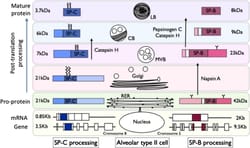Lopez-Rodriguez, E., Cruz, A., Richter, R.P., Taeusch, H.W., Pérez-Gil, J.: J Biol Chem. 2013;288(41):29872-81.
To access the full article, click here:

Pulmonary surfactant is a lipid-protein complex that lowers surface tension at the respiratory air-liquid interface, stabilizing the lungs against physical forces tending to collapse alveoli. Dysfunction of surfactant is associated with respiratory pathologies such as acute respiratory distress syndrome or meconium aspiration syndrome where naturally occurring surfactant-inhibitory agents such as serum, meconium, or cholesterol reach the lung. We analyzed the effect of hyaluronan (HA) on the structure and surface behavior of pulmonary surfactant to understand the mechanism for HA-promoted surfactant protection in the presence of inhibitory agents. In particular, we found that HA affects structural properties such as the aggregation state of surfactant membranes and the size, distribution, and order/packing of phase-segregated lipid domains. These effects do not require a direct interaction between surfactant complexes and HA and are accompanied by a compositional reorganization of large surfactant complexes that become enriched with saturated phospholipid species. HA-exposed surfactant reaches very high efficiency in terms of rapid and spontaneous adsorption of surfactant phospholipids at the air-liquid interface and shows significantly improved resistance to inactivation by serum or cholesterol. We propose that physical effects pertaining to the formation of a meshwork of interpenetrating HA polymer chains are responsible for the changes in surfactant structure and composition that enhance surfactant function and, thus, resistance to inactivation. The higher resistance of HA-exposed surfactant to inactivation persists even after removal of the polymer, suggesting that transient exposure of surfactant to polymers like HA could be a promising strategy for the production of more efficient therapeutic surfactant preparations.




